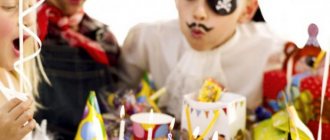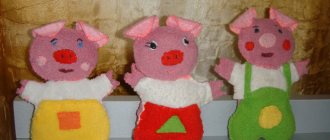Children's birthday is a very important holiday for children. They often remember the most successful events throughout their lives. How to organize a child’s birthday so that the birthday boy and the invited guests like it, and for adults it doesn’t become a reason to break their head, coming up with a scenario and entertainment?
For most parents, every child's birthday is a joyful, but slightly stressful time when it comes to preparation. Luckily, you don't have to throw a perfect and expensive event for your little birthday boy and guests to have a good time.
First of all, you need to decide where the party will be held, at home or in a rented room - the first option is cheaper, but the second allows you to avoid cleaning and possible damage.
You also need to decide on the number of guests at the event. If there are few children, then there is no need for extensive preparation. It is enough to create a menu and organize several competitions (always with prizes).
If there are relatively many guests planned, then it would be good to organize a thematic event, based on the preferences of the little birthday boy and his guests.
The most popular event themes are fairy tales and films (Avengers, Monster High, Disney cartoons, My Little Pony, lol, etc.); which involve characters from fairy tales (unicorns, pirates, princesses and princes), animals (kittens, dinosaurs), as well as children's games and hobbies (football, fire department, Lego).
You will need to think about accessories and decorations that match the theme, invitations, possibly costumes, and a sweet table.
But, of course, the most important thing at a children's party is the fun that is created with the help of active competitions and prizes for participation in them, shows, and music.
Even in completely children's competitions, it will be interesting for adults to participate. Each competition can be “tailored” to the desired scenario (the theme of the holiday) and made accordingly.
Competitions for children's birthdays
cartoon heroes
The presenter voices various characters (names) from famous cartoons, and the children must quickly remember and say the full name of this cartoon. For example, Vintik, Shpulya ("Fixies"), Uncle Fyodor, cat Matroskin, ("Three from Prostokvashino"), Gecko, Alet ("PJ Masks"), Losyash ("Smeshariki"), Caramelka ("Three Cats") .
You can divide the players into teams or each for themselves (depending on the number of participants). For the correct answer (who is faster) give a token. The one with the most wins.
Favorite color
Each participant chooses a marker of their favorite color and receives a sheet of paper. On command (or turn on the music track), players must draw on their sheet such objects that have the selected color of the felt-tip pen. For example, if it is yellow, then you can draw the sun, lemon, boots, book, etc. Whoever draws the most objects in 2-3 minutes wins.
At any festive event, as entertainment for guests, you can conduct an exciting quest to find a reward (gift, sweets or small souvenirs). Check out our ready-made kits. Preparation will take about 30 minutes, and the fun and exciting search will take 1.5 - 2 hours.
Try again
Stick it on the wall (or put a blank sheet of paper on the table). Place the participant in front of this sheet. Tape the second sheet of paper onto the back of this participant. Another person draws on his back (on a glued sheet) some kind of intended picture, for example, a house, but not all at once, but in parts (roof, square, window, door), and the one on whom they draw must try to repeat everything on on your sheet. The one (couple, team) who has the most similarities wins.
Wrap it up
Tie a long rope, for example, a straw for drinks, on one side, and an object, for example, a car or a soft toy, on the other. Make such sets according to the number of teams. Whoever wraps the entire rope around the tube the fastest wins.
One two Three…
Children stand in a circle. Some kind of prize is placed in the center. The presenter begins to count: “One, two, thirty...twenty.” "One, two, three...eleven." “One, two, three...twenty-three.” “One, two, three...step.” The participants’ task is to grab the prize on the count of “one, two, three.” Whoever reacts first gets a reward.
Here you can divide the players into pairs and play this game several times.
Tubes and papers
Cut several sheets of paper of different colors (for example, red, blue, yellow) into small squares according to the number of participants. Give each participant a cocktail straw. The task is to use a straw to suck up only your own color of paper (each player chooses their own color) and fold it in front of them (can be in any container). The winner was the one who managed to collect the most pieces of paper without errors in the set time (2-3 minutes).
As an option: on one of the squares (of each color) make some kind of mark, for example, an asterisk and turn it over with the pattern down. Whoever finds this star faster (using the above method) will receive an additional prize or be the winner of the game.
The brain and nervous system are the “keys” to understanding the world around us
Now it’s no secret that the baby, while still in the womb, reacts to the emotional state of the mother and sounds coming from the outside. The leading role in this mechanism is given to the brain and nervous system, which ensure the interaction of the baby with others both in utero and immediately after birth. At the same time, the brain perceives signals coming from the outside and analyzes them - clear connections are formed that influence the development of the baby.
And if some connection is used often, it becomes permanent and stable. Meanwhile, when a connection is rarely or not used at all, its chances of being preserved are low.
For example, when a baby hears speech around him from birth, he is more likely to learn to speak faster. Whereas if a child of early years was spoken to little, rarely or not read to him, most likely it will be difficult for him to master the skill of speech.
Therefore, in order for the brain to turn into a thinking and emotional organ, it is necessary to give it “food” - vivid impressions and positive emotions.
There are three main points in human training:
- Dependence on genetically determined abilities and upbringing (stimulation of learning, encouragement and care).
- Features of the brain of children in the first years of life: they benefit greatly from any experience and proper training.
- The process of acquiring new knowledge continues throughout human life.
However, in striving to give the best to your child, as in any other endeavor, it is important not to overdo it. And the best way is to observe the baby to determine his preferences. Therefore, surround your child with care, parental attention and affection.
At the same time, remember that the baby feels the need to explore, which must be encouraged by talking, smiling, physical contact (for example, stroking or kissing), singing, and so on. Otherwise, the baby will quickly lose interest and desire to learn the unknown.
So, let's introduce the baby to the world around him, full of new sensations and interesting activities.
How an elephant sneezes
Short interactive session with the audience. It will come in handy, as a fun break between performances.
The presenter asks the audience if they heard an elephant sneeze? Do they want to hear?
Further, the hall is divided into three parts. The first part is given the chant: “boxes”, the second - “cartilage”, the third - “dragged”. First, the leader gives commands to each group to shout out their word. Then he asks to shout out in unison! After a friendly “boxes, cartilages, dragged,” the presenter says that this is how an elephant sneezes.
Nonverbal communication - transferring information without speech
Each of us in adult life at least once asks ourselves the question: how does the object of my adoration, business partner or work colleague treat me? In most cases, we find the answer to it within ourselves. Sometimes he makes us happy. However, it also happens that it disappoints, so we don’t want to believe in our conclusions, tormented by doubts. Well, when all the i’s are dotted, we complain that we didn’t listen to our intuition earlier.
In fact, we draw a conclusion unconsciously, analyzing the behavior of our partner: his gestures, facial expressions, postures, and so on. That is, we understand his emotional state in “body language” - nonverbal communication.
In the same way, the child, at the subconscious level, feels how others treat him.
Therefore, convey to your baby in various ways that you love him. Then he will feel safe.
Nonverbal games
- While performing hygiene procedures, changing clothes, or performing physical exercises, quietly say (you can hum) simple words: I press you and kiss you, I love you. At the same time, gently kiss your nose, fingers, and palms, confirming your words with action.
- Mom is the closest person to a child, since his existence depends on you. After all, it is to you that he sends an SOS signal in the form of crying or grunting when “danger” appears: hunger, thirst, pain, and so on. Therefore, seeing your face, the baby perks up and rejoices. So don't deprive him of such pleasure.
One of the game options
Lean close to your baby and sing him a song or gently say:
"Hello, hello, I love you so much
Hello, hello, I can touch you
Hello, hello, touch the little nose
Hello, hello, kiss your little nose.”
Moreover, you can repeat the poem, and when pronouncing the last line, name other parts of the face: lips, eyelids, eyes.
Six to twelve months
Motor, auditory and visual skills
- Squats and jumping ups
- Sitting without support
- Lifting your legs off the bed of the crib
- Rolling a ball while sitting in a crib
- Fast crawl
- Climbing stairs
- Standing without any help
- Movement of the hand in the direction of gaze
- Ability to grasp small objects with thumb and index finger
- Ability to place several objects in a cup or bowl
- The ability to knock a cube on a cube
- Looking at pictures in a book
- Ability to put small objects into a box or basket
- Responsiveness to voice tone and intonation
- Distinguishing familiar words and responding appropriately to them
- The ability to shake a bell, trying to reproduce a sound
- The ability to stop doing something if you are told “you can’t”
- Showing interest in individual words and gestures
Language and cognitive skills
- Imitating speech sounds
- Rhythmic babble
- A combination of two syllables like "mama" or "papa"
- Imitating sounds made by animals
- Saying the first real word other than "mama" and "dada"
- Attracting attention to yourself with sounds and noise
- Ability to clap hands
- The ability to wave goodbye
- Follow simple directions
- Understanding the word "cannot"
- Shaking your head in denial
- Pulling a string with a toy tied to it towards you to get it out
- Finding something hidden under a cup
- Understanding the meaning of the words “mom” and “dad”
- Removing an object previously shown to the child from a cup
- Squeezing toys to hear a squeak
- The ability to look around to find a toy that is not currently visible
Self-knowledge skills
- Seeking or demanding attention
- Repulsing other hands trying to pick up a toy
- Holding your hands in front of your face to avoid washing your face
- Reaching out to be held
- Ability to eat liquid food from a spoon
- Ability to pick up, bite and chew a cookie or biscuit
- Ability to eat by picking up food with fingers
- Ability to drink from a cup with someone's help
- Holding back your drool
- Appropriate reaction to adult facial expressions
- The desire to repeat actions that caused laughter
- The ability to experience pleasure from communication
- Participation in dressing using hands
Toys for children under 1 year old
The question of what kind of play equipment will be needed for babies under one year old is quite relevant. During this age period, the child is just getting acquainted with the world, so it is necessary to ensure comprehensive development by selecting the right toys.
Play equipment for newborns and infants must meet certain requirements. When purchasing, it is important to pay attention to the following qualities:
- attractiveness and brightness (black and white toys are suitable for newborns);
- ease;
- environmental friendliness of materials;
- variety of textures;
- ease of care;
- no removable parts or fragile elements;
- relatively large sizes so that the baby cannot push the toy into his mouth;
- absence of loud and sharp sounds that could frighten the baby;
- no sharp corners.
It remains to use specific examples to understand which toys are suitable for kids. So, for babies in the first half of life you can purchase:
- rattles;
- fabric balls;
- rings;
- mobiles;
- mats for development.
As the child grows up, the range of play accessories will expand significantly. For children in the second half of their life, the following are perfect:
- musical accessories (piano for kids);
- a small pyramid with rounded edges;
- inserts;
- nesting dolls;
- sorters;
- finger theater;
- soft books;
- cubes (preferably soft too);
- tumblers;
- balls.
All these toys should not be presented to the baby at once, since the baby will only be able to play with one or two. Offer these two toys, and after a few days replace them with others so that the child does not get bored.
Below are activities with a child by month from 0 to 1 year. Of course, it is not necessary to follow them exactly, but they should still be taken into account. This will help you create your own early development program.







